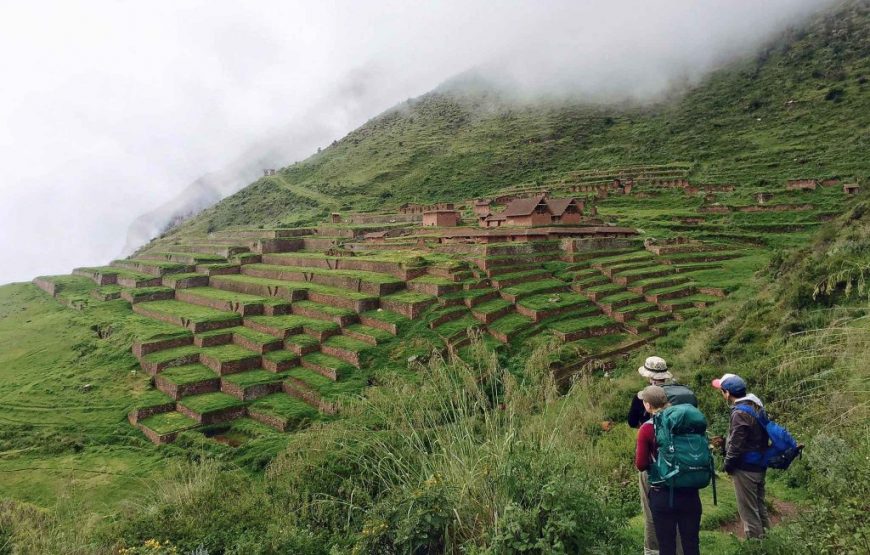from 4 reviews
8 Hours
No Cancellation
10 people
English, Espanol, Português


We offer Huchuy Qosqo 1 day hike. Its name is Quechua “Little Cusco”. It lies at an elevation of 3,650 meters (11,800 feet), above the 3000-meter high town of Lamay and the Sacred Valley.
The Huchuy Qosqo 1 day hike, is a stunning route, accessible only by foot, with sweeping views over the Sacred Valley. Besides, the trek surrounded by breathtaking scenery of snowcapped mountain range of Urubamba. Likewise, the Huchuy Qosqo 1 day hike near Sacred Valley is for those who like a challenging hiking adventure.
Above all, the hike leads up to the ruins of “Huchuy Qosqo” before descending a series of switchbacks to Lamay village, the end of your hike. If you have more time, this route can also be organized with Machu Picchu. Explorer
Huchuy Qosqo Trail 1 Day Trek: Daily Departures
Overview of Huchuy Qosqo 1 Day Hike
Early morning pickup at your hotel
Private transfer to the trailhead “Qenqo”.
Walking distance: 16 km / 10 miles.
Estimated duration: Approx. 8 hours.
Highest point: 4000 m. /13,123 ft.
Location: The Andes of the Sacred Valley of the Incas
Difficulty: Moderate – Challenge “Huchuy Qosqo 1 Day Hike”
Price of Huchuy Qosqo 1 Day Hike
We require a minimum of 2 people for this trek, but you can leave any day would you like. The departure is 100% Guaranteed once booked. Request a Quote: We can customize this trek just for you. We guarantee the perfect experience by arranging this tour.
02 people, US$ 120 per person.
03 people, US$ 110 per person.
04 people, US$ 100 per person.
05 people, US$ 90 per person.
06 people, US$ 80 per person.
07 people, US$ 70 per person.
08 people, US$ 60 per person.
09 people, US$ 55 per person.
10 people, US$ 50 per person.
Huchuy Qosqo: The Little Cusco is an archaeological site north of Cuzco, Peru it was originally an administrative and military center as Pisaq, with many constructions around, Inca buildings with perfect fine stones work, graneries structures called Collcas to store and preserve food, because it was an important agricultural center to produce corn. Its name is Quechua for Little Cusco It lies at an elevation of 3650 meters (11,800 feet), above the 3000-meter high town of Lamay and the Sacred Valley. The site received its name in the 20th century previously it had been known as Kakya Qawani. Pedro de Cieza de León, in his Second Chronicle of Peru, claimed that the palaces were built by Viracocha, the Eighth Inca. Amongst a large number of buildings, some stone, some adobe, is a kallanka (great hall), 40m long. Providing water to the site is an Inca built irrigation channel, lined with stones for about 800m. The site is inaccessible by public road.
For our Huchuy Qosqo 1 Day Hike, we’ll provide you a thorough briefing at your accommodation in Cusco at 5:00 pm, the night before your trek, and you can take this opportunity to ask final questions and make any final preparations.
Approx 06:00 am transfer from your hotels, with private vehicle for 1.5 hours to Patabamba community located at 3700 masl. On route we pass Saqsaywaman and Tambomachay before arriving to the Sacred Valley of the Incas. Beautiful Andean village with amazing landscapes in the land of great wool weavers, they use ancestral Inca tecniques to create amazing textiles. We will pass a few small communities such as Siwas, Qenqo and Pumamarka where you can see locals farming their lands with potatoes and bean crops as their ancestors did. This little valley is beautiful with a lot of native trees, flowers and bushes. Our trek will start with a gentle walk of a small ravine after 2 hours then we need to climb around 400 meters to the reach Pumamarka ruins, the walk from here is one hour to reach the Inca site of Huchuy Qosqo, recently restored by archaeologists, located at 3,450 mals from this point it is clear to see many beautiful mountains as Chicon, Pitusiray, Sawasiray, Waccaywilca or Veronica ancient sacred mountains "Apus" so respected and venerated by the locals Incas- Quechuas descendents living in this valleys for centuries. This Inca site is amazing, we arrive and have enough time to rest, relax and recover with a delicious pack lunch, then we will be ready for our guided tour to visit and explore this interesting Inca complex.
Then we start our all walk down to Lamay, about 2 hours with stops.
Transfer back to Cusco with Guide in a private transport.
A daypack with a change of clothes for the whole period of the trek
Rain jacket or poncho (plastic ponchos can be purchased in Cusco)
Strong footwear, ideally trekking or sport shoes
Snacks: biscuits, energy bars, chocolate, fruits,
Camera, film and batteries (batteries consume more quickly under cold conditions)
Hat to protect you from the sun, rain and cold
Insect repellent, minimum recommended 20% DEET
Sun bloc.
While we expect the tour will run as the itinerary describes. Participants should accept that there is the possibility of changes, being necessary liable to local conditions, e.g, strikes, natural disasters, these changes might be at the discretion of your travel company.